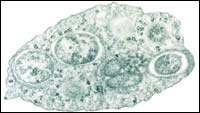’Male-killer’ bacterium’s genome is deciphered

Wolbachia have a thing against males. A member of one of the most diverse groups of bacteria, called Proteobacteria, this parasitic “endosymbiont” lives inside the reproductive cells of a wide variety of the nearly one million species of arthropods, including insects, spiders, and crustaceans.
Wolbachia’s effects range from beneficial to pathological, but if the host is male, the infection often turns out badly. The reason is the Wolbachia are transmitted through females, and to increase the chances of being passed on from one generation to the next, the bacterium has developed a number of strategies to rid the population of males, or even to convert them to females. As far as Wolbachia are concerned, males are irrelevant.
The biochemical mechanisms that trigger different strategies in different hosts are unclear, however, in part because it has so far been impossible to grow sufficient quantities of these bacteria outside their host. But now that Scott O’Neill, Jonathan Eisen, and colleagues have sequenced the complete genome of one strain of Wolbachia pipientis, scientists are already gaining new insight into the biology and evolution of Wolbachia-host interactions.
The work is also likely to have practical applications – it has been proposed that Wolbachia could be used to control insect pests. It might also provide a new approach to the control of human and animal filariasis (diseases such as elephantiasis), since the worms that cause filariasis require the endosymbiotic Wolbachia for survival.
Citation: Wu M, Sun LV, Vamathevan J, Riegler M, Deboy R, et al. (2004) Phylogenomics of the Reproductive Parasite Wolbachia pipientis wMel: A Streamlined Genome Overrun by Mobile Genetic Elements. PLoS Biol: e69 DOI: 10.1371/journal.pbio.0020069
Media Contact
All latest news from the category: Life Sciences and Chemistry
Articles and reports from the Life Sciences and chemistry area deal with applied and basic research into modern biology, chemistry and human medicine.
Valuable information can be found on a range of life sciences fields including bacteriology, biochemistry, bionics, bioinformatics, biophysics, biotechnology, genetics, geobotany, human biology, marine biology, microbiology, molecular biology, cellular biology, zoology, bioinorganic chemistry, microchemistry and environmental chemistry.
Newest articles

Properties of new materials for microchips
… can now be measured well. Reseachers of Delft University of Technology demonstrated measuring performance properties of ultrathin silicon membranes. Making ever smaller and more powerful chips requires new ultrathin…

Floating solar’s potential
… to support sustainable development by addressing climate, water, and energy goals holistically. A new study published this week in Nature Energy raises the potential for floating solar photovoltaics (FPV)…

Skyrmions move at record speeds
… a step towards the computing of the future. An international research team led by scientists from the CNRS1 has discovered that the magnetic nanobubbles2 known as skyrmions can be…





















